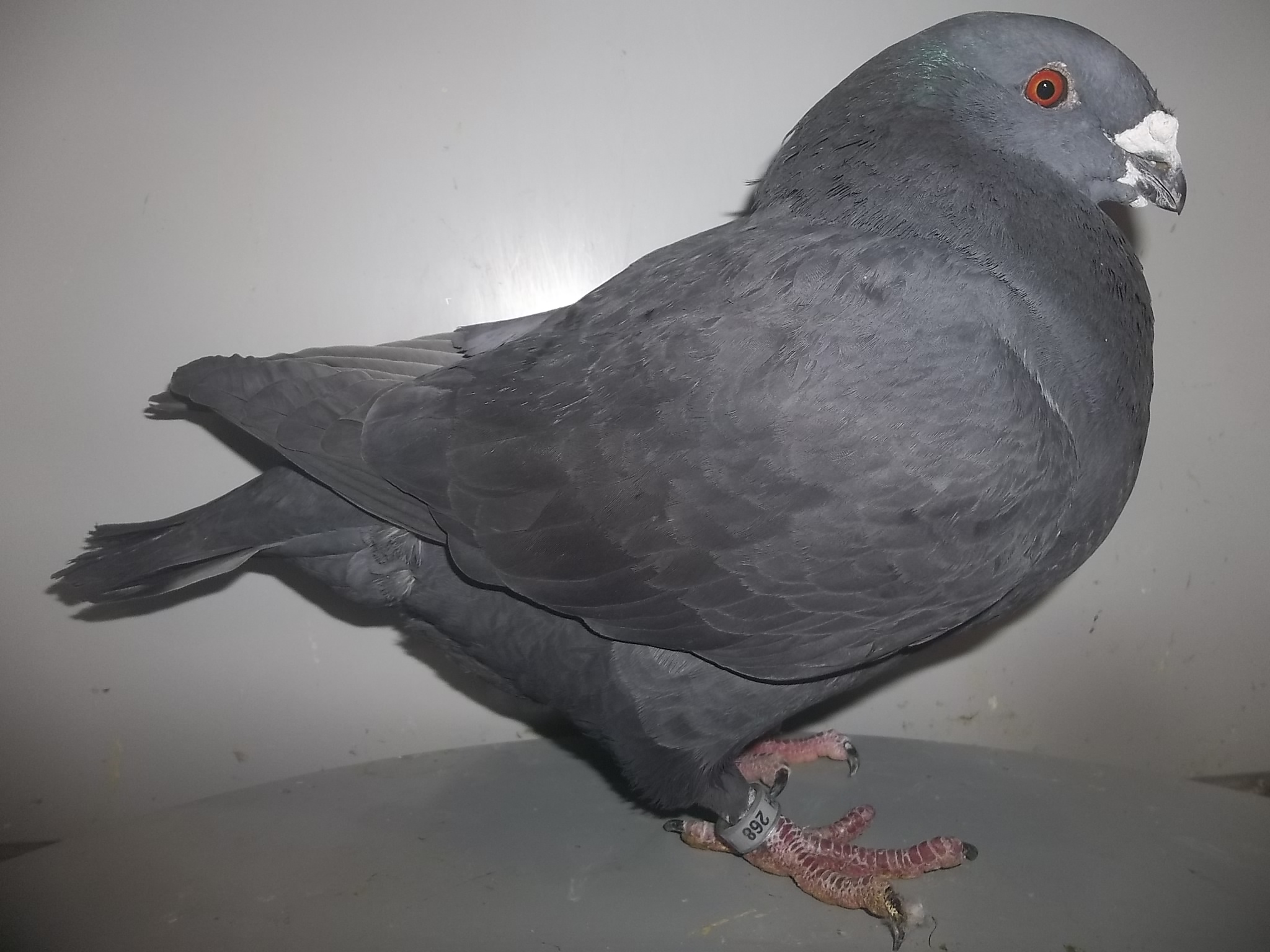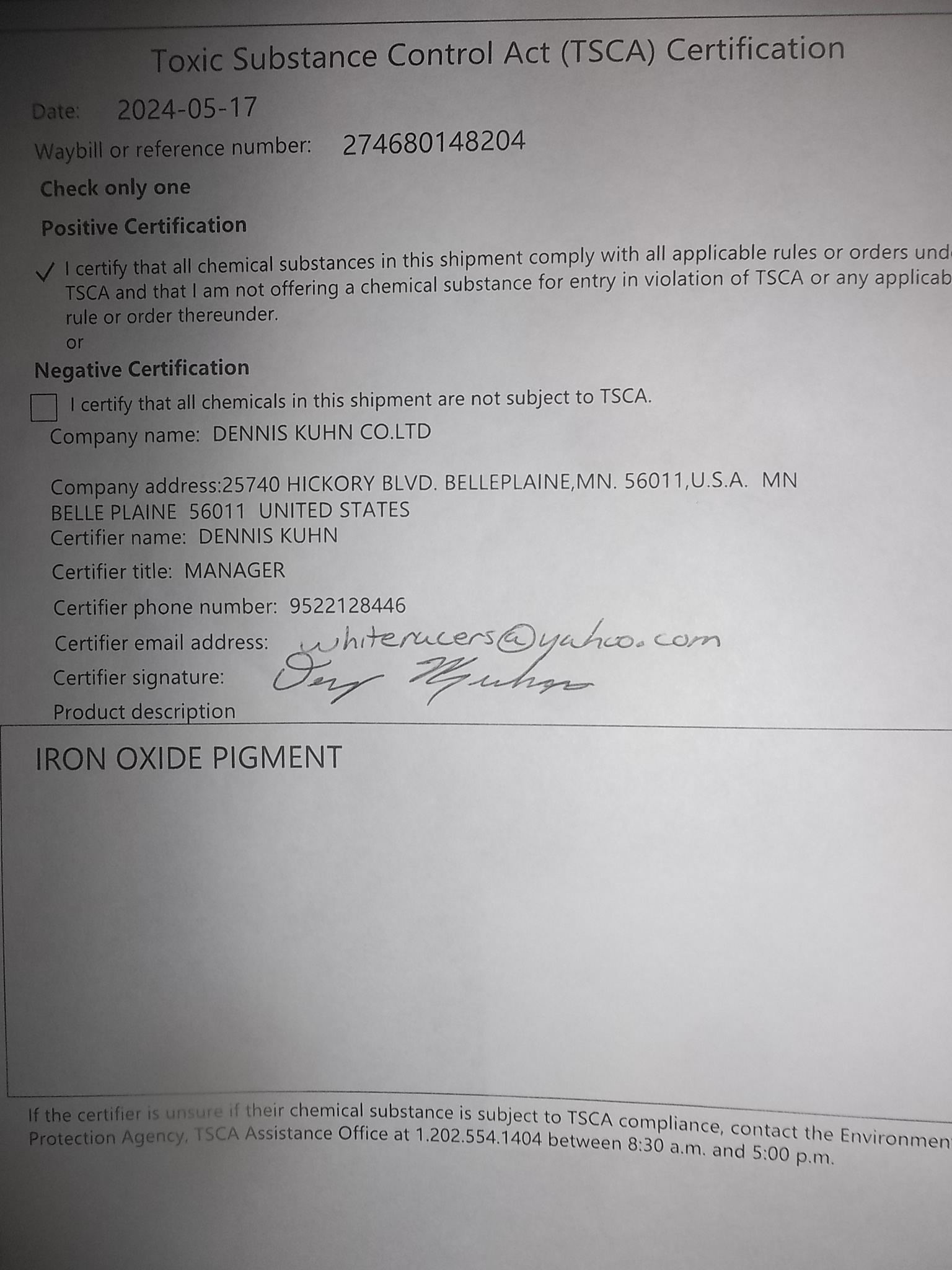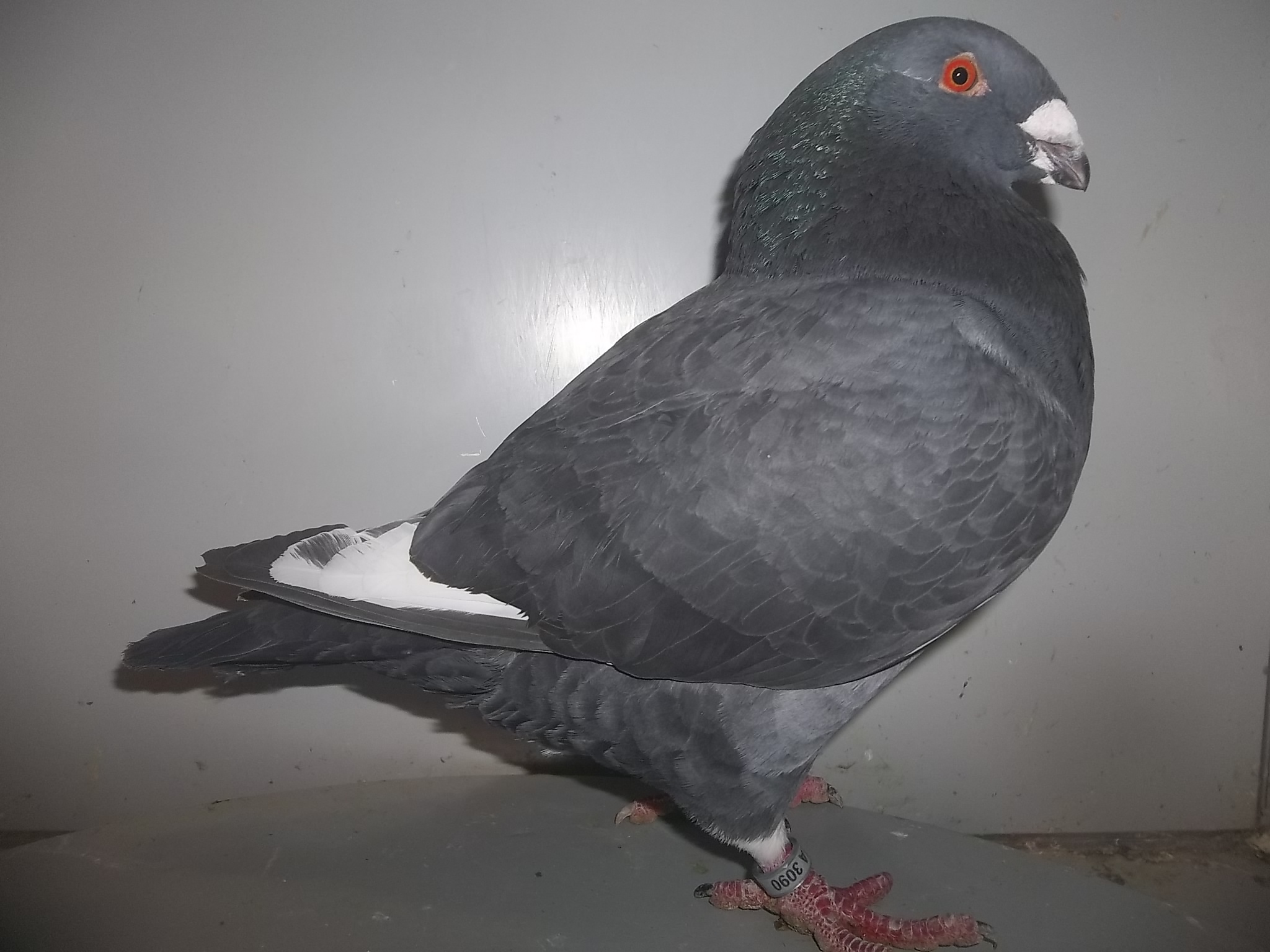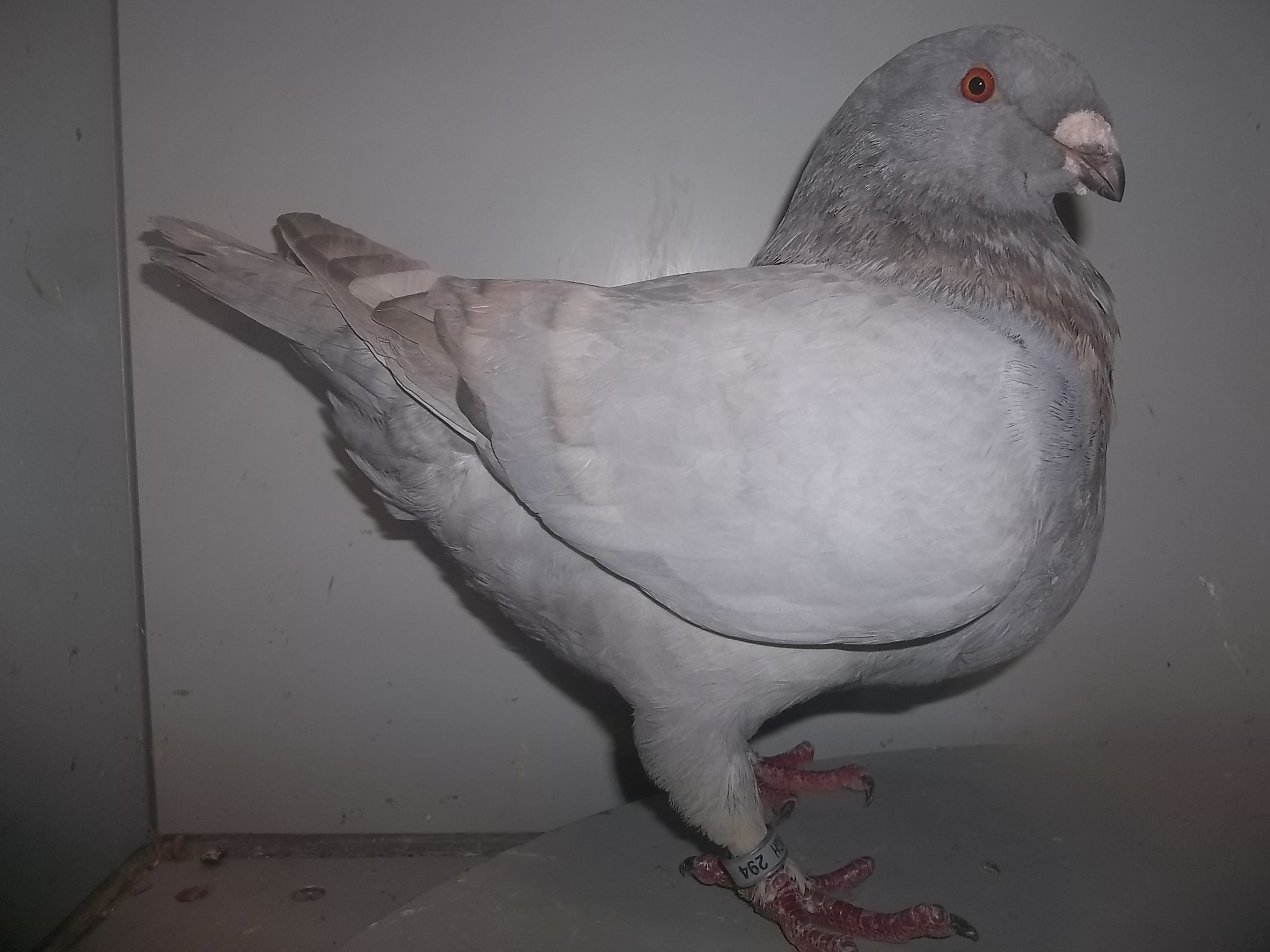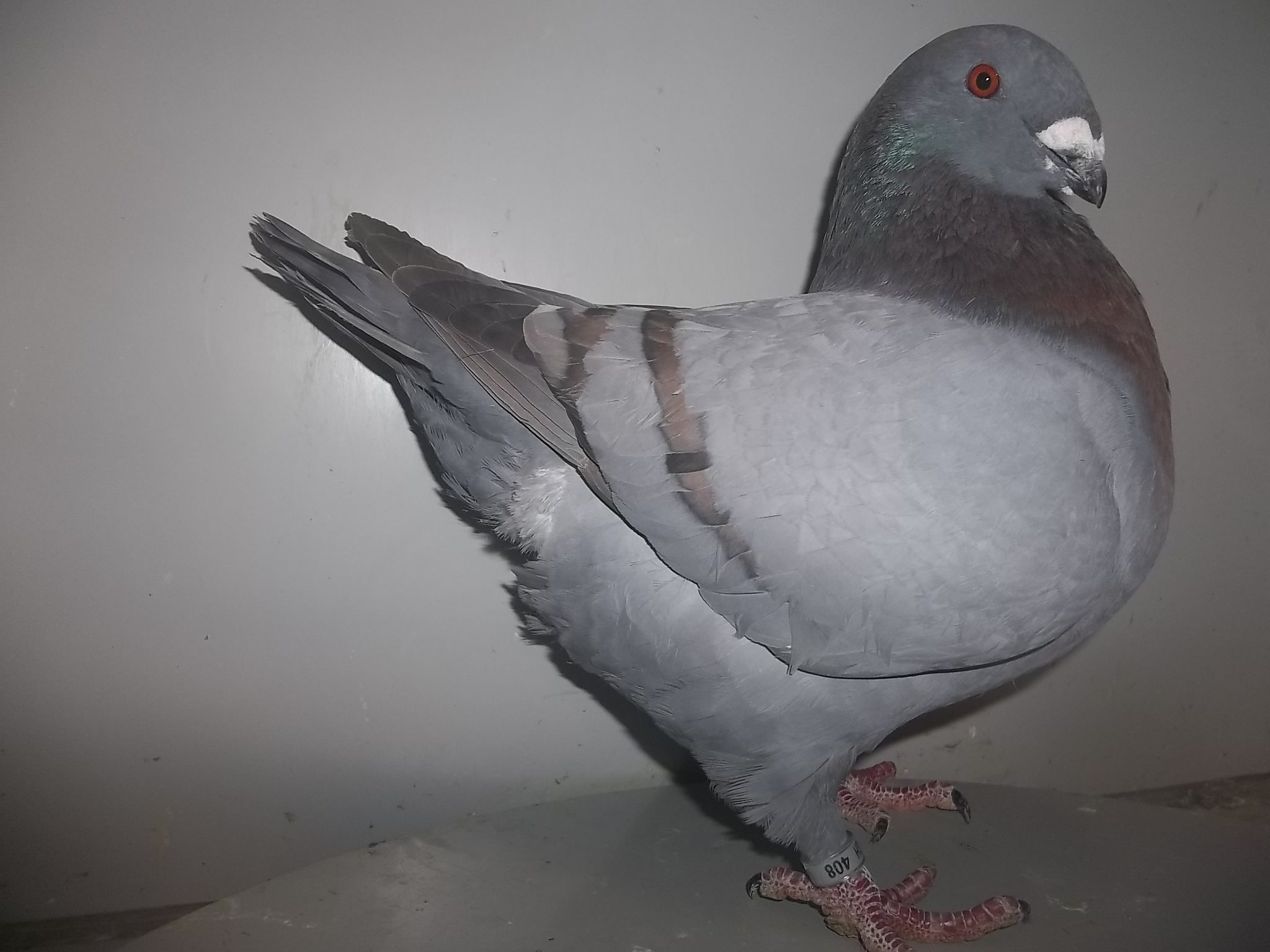

2011' & 2012' Racing Highlights in Heartland Federation
Sale Priced Hens ($95 or less)
Sale Priced Cocks ($95 or less)
Rare Colored Homers 4-Sale pg. 2
JANSSEN RACING PIGEONS Coming Soon
Houben, Flor Engel, Koopman, Van Loon 4-Sale
Sale Priced White/White Grizzle
|
Giant Homers are truly an American breed. Developed in the USA after the 1920s from squabbing and show homers this breed shows in most all colors and patterns. The early motto of the national club was "A breed fit for the showroom that can outproduce any pigeon on earth." There have been significant changes to the breed over the last 10 to 20 years, with major improvements in head qualities, body structure and overall size. Originally limited to 22 to 27 ounces, individual birds now tip the scales at well over two pounds and many equal the size of the Show King and the French Mondain. Show Standard listed below acccording to American Giant Homer Association... PREFACE. This standard is a guide for evaluating the specific features as well as the total, composite quality of the giant Homer. A fancier may well concentrate his attention on a single feature such as neck creases, back cover or head when judging an individual bird’s value for his breeding program. A show judge, however, must concentrate his attention on the total bird the effective composite of all features of the individual bird. Further, the show judge must then rank a class of birds by a careful comparison of their differing composites of quality. This standard assigns point values to the specific features to aid the judge in estimating the importance of individual strengths and weaknesses in comparing and ranking a class of birds. A proper application of those point values eliminates the real need for a listing of outright disqualifications. It is strongly recommended that every show judge keep this written standard as well as a copy of the 3-view standard sketch before him as a reference and guide in judging. He should leave no doubt in the minds of exhibitors that he is doing his best to understand and apply the official standard in making his decisions. TYPE. The term “type” commonly refers to the combination of the bird’s conformation, station, and profile. It is clearly illustrated in the three-view sketch of the ideal. In terms of show points, type is recognized and rewarded within the specific structural features of the standard. One should refer to the three-view sketch of the ideal as it relates to all of the items in the written standard. SIZE. Successful show birds will commonly show moderate variations in size with a range from 10″ to 11″ in height, from 91/2″ to 101/2″ in length, and from 5″ to 6″ across the wing butts. Concern for excellence in type should take preference over concern for size alone. However, excessively large or excessively small birds are both quite undesirable. WEIGHT. A top quality bird in good show condition will have a distinctly solid feel in the hand. Looseness and fatness are undesirable qualities and will be penalized. The ideal weight of a cock is 35 ounces with a range of 30 to 40 ounces. The ideal weight of a hen is 33 ounces with a range of 28 to 38 ounces. Birds within these ranges shall be judged as equal to one another in SIZE. Birds that are outside this standard will have points deducted accordingly under the point allotments that follow. (Revised 6/1/96) HEAD. (15 points) Head profile raising gradually and smoothly from tip of beak to above the eye, then descending in an unbroken line to the neck. Top skull showing no flatness. Top – view showing good width between the eyes, narrowing smoothly toward the wattle. No sign of gullet or of pinching above the wattle. No show of angularity in outline. The whole head should express strength with no sign of weakness or thinness. EYES. (5 points) Sharp and clear expressing alertness. Ruby red or orange in color with ruby red preferred. Gravel, pale or cracked eyes a serious fault. A bull or solid eye is admissible in whites or splashes. Both eyes the same color. False pearl eye acceptable in browns and khakis. EYE CERES. (2 points) Medium size, neat, smooth and even. May vary from dark or plum color in colored birds to flesh color and pink in whites and white splashes. BEAK. (5 points) medium length, stout ant straight. Both mandibles of nearly equal strength and substance. Set smoothly into face with no broken outline. No sign of gaping or crossed mandibles. May vary in color from dark in colored birds, to amber in red checks, to flesh color preferred in whites and permissible in white splashes. WATTLE. (2 points) Medium size, smooth in texture and free of coarseness. Should fit smoothly between head and beak. Free of warty growths at base of lower mandibles. NECK. (5 points) Stout, medium length. Tapering gradually- and smoothly from head to shoulders. No signs of neck creases or gullet. BODY STRUCTURES. A total of 36 points is allotted to the closely related body components including body, breast, back and keel. This retains a strong emphasis on the utility nature of the breed. At the same time, substantial point allotments to refinements in eyes, beak, legs, head, color and pattern affirm the increasing status of Giant Homers as an exhibition breed with a pleasing balance of power and beauty. BODY. (16 points) Short, broad, deep, and strongly built. The body as a whole presents a smoothly tapered, wedge-shaped appearance that is clearly felt in the hand. The rump is well filled and tapered and without the wideness and flatness that causes wide tails. BACK. (5 points) Flat and straight with broad shoulders tapering to a well filled rump. Forms a line with the tail carried at about a twelve degree angle below the horizontal. BREAST. (10 points) Prominent, broad (5″ to 6″ across the wing butts). Deep and well rounded. Showing well beyond and below the wing butts. KEEL. (5 points) Deep, straight and extended well into the rump. Rocker shaped in side view, curving slightly toward vent but maintaining good depth at rear to assure a well filled rump. Well covered with solid, muscular flesh. WINGS. (10 points) In proper proportions to length of body. Prominent and powerful through shoulders to butts, fitting closely to the body in front view. Flights resting on the tail with the two wing tips touching or nearly so. There are to be ten (10) primaries in each wing. If more than ten (10) primaries, this fault shall carry the same weight as having less than 10. Wing coverts should cover the rump smoothly and well. Primaries strong in web and quill. Entire shield of wing fitted with smooth, tight, closely overlapped feathering. No tendency for wing tips to fall below the tail or to cross over rump. Primaries and secondary firmly overlapped and clinging. No tendency to sideboards. (Revised 6/1/96) Tail. (5 points) Twelve firmly set feathers with strong web and quill. Spreads to a full fan with feathers firmly overlapped and clinging to each other with no sign of splitting. Carried well closed with feathers overlapped to give appearance of little more than one feather in width. Short, not extended over one inch beyond tips of flights. carried at about a twelve degree angle below horizontal and in a straight line with the back. Fits smoothly into a full rump cushion above and below. LEGS AND FEET. (5 points) Legs medium length and set well apart in a slightly bent stance. Strong in appearance denoting thickness of bone. Thighs full and muscular. Shanks and feet free of feathers. Toes strong and straight with no improper webbing. There are to be four (4) separate, individual toes on each foot as clearly depicted on the current standard. All toes are to be uniform and properly proportioned and complete with nail. Toe nails uniform in color corresponding to that of the bead. (Revised 6/1/96) SHOW CONDITION. (10 points) Sound, healthy and alert with smooth and finished feathering throughout. No dirty feathers, feet or toe nails. Calm and poised in show cage. Handles and holds station without wildness. Not overly fat or thin. Birds with deformities should be cut in accord with the foregoing standard. Diseased birds must be removed from competition and from contact with other birds. COLOR AND PATTERN. All colored birds are regarded as carrying ten (10) floating points which shall be cut at the discretion of the judge for faulty color or pattern within a given color class. These ten floating points are in addition to the 100 basic points established in the standard. Quality of color and pattern is disregarded in judging specials beyond best of color. See standard color classifications. Mismarked and miscolored birds should be classified and judged as such under the specifications set forth for CLASS XIV, AOC in this standard. |
|
|
|
|
|
|
17 NPA 289 Indigo Bar Cock Price is $40 plus shipping SOLD DC |
| 16 NPA 353 Dun Hen Price is $35 plus shipping SOLD LQ |
|
| 13 NPA 324 Indigo Bar Hen Price is $30 plus shipping SOLD |
|
| 17 NPA 2566 Opal Hen? Very rare color. Price is $55 plus shipping SOLD LQ |
|
| 13 NPA 1296 Yellow Hen Solid yellow bird. Price is $40 plus shipping SOLD MD |
|
| 17 NPA 424 Blue Bar Cock Price is $45 plus shipping SOLD |
|
| 16 NPA 354 Dun Hen Price is $40 plus shipping SOLD DC |
|
| 15 NPA 586 Kaki Bar Hen Price is $40 plus shipping SOLD |
|
| 17 NPA 3090 Black W/F Cock Price is $45 plus shipping SOLD DC |
|
| 17 NPA 294 Opal Bar Cock Price is $45 plus shipping SOLD LQ |
|
|
|
17 NPA 408 Opal Bar Hen Price is $45 plus shipping SOLD LQ |
|
|
|
